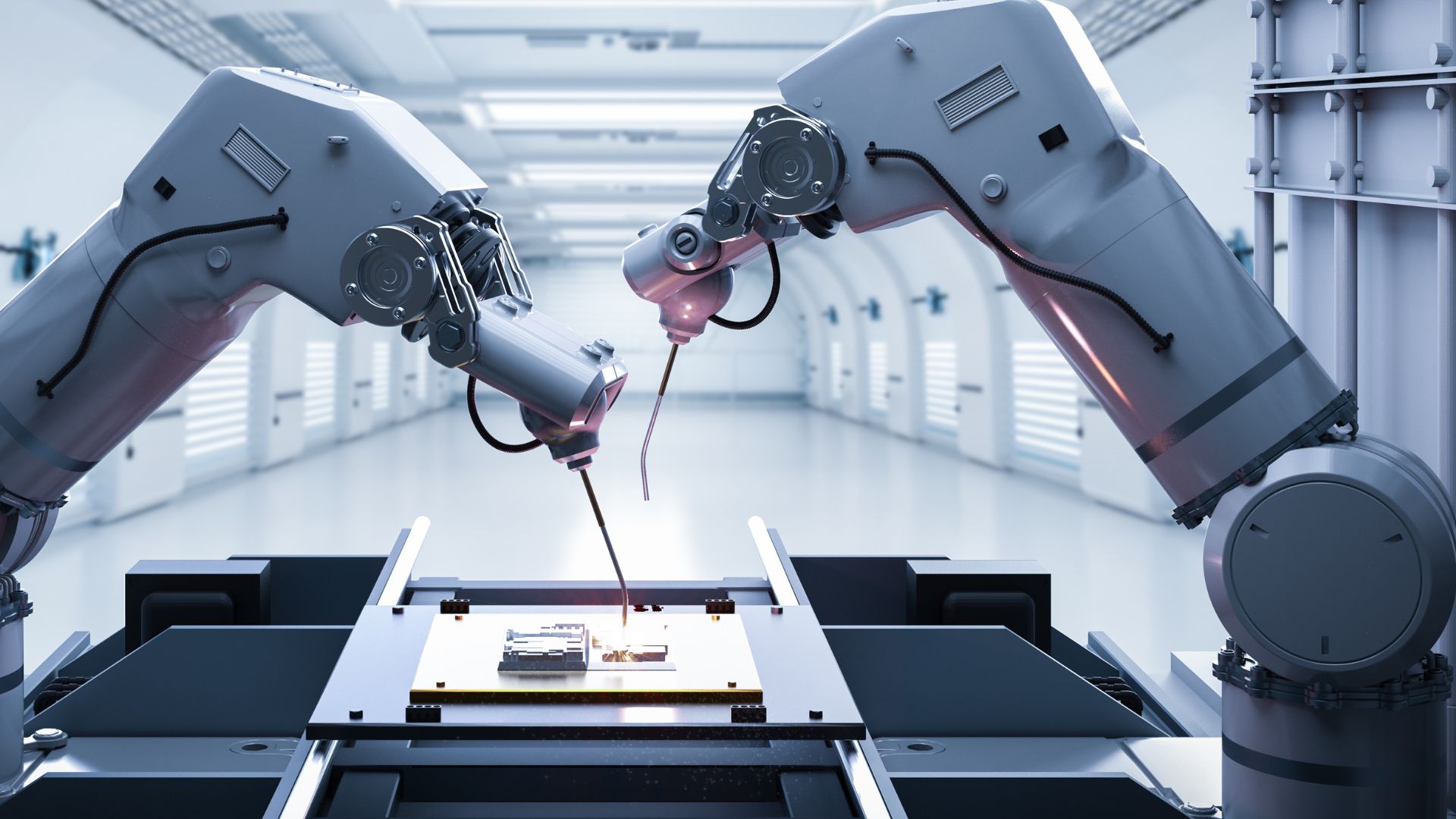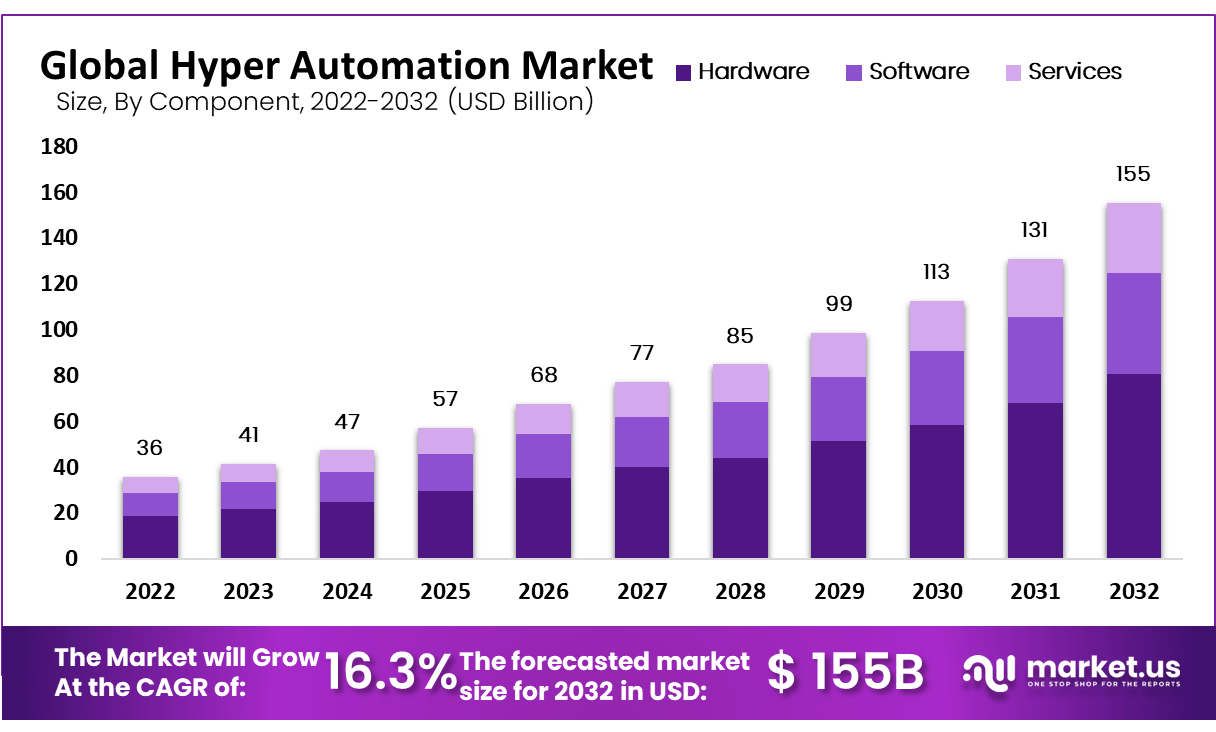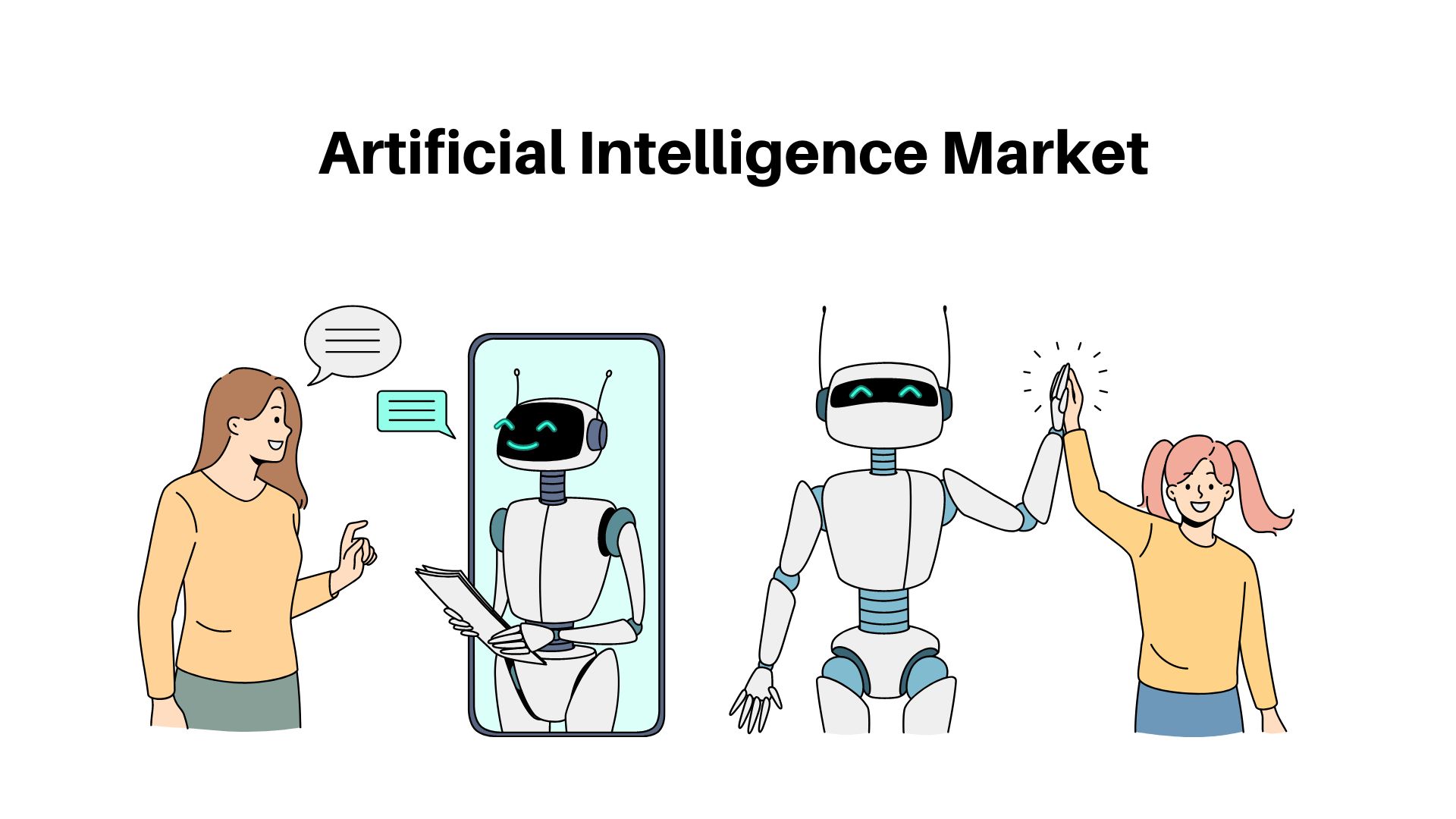Hyper Automation Market Sales to Top USD 155 Billion in Revenues by 2033 at a CAGR of 16.30%

Page Contents
Market Overview
Published Via 11Press : Hyper automation market is the combination of technologies such as artificial intelligence, machine learning, robotic process automation (RPA), and cognitive computing. This approach aims to automate as many business processes as possible, including those that were previously too complex or unstructured for traditional automation techniques. Hyper automation enables businesses to streamline their operations by reducing human intervention in repetitive tasks and decision-making processes.
The Global Hyper Automation Market size is expected to be worth around USD 155 Billion by 2032 from USD 36 Billion in 2022, growing at a CAGR of 16.30% during the forecast period from 2023 to 2032.
The demand for hyper-automation solutions is driven by the increasing need for advanced technology to improve operational efficiency and reduce costs. Businesses across various industries are adopting hyper-automation solutions to increase productivity while minimizing errors and delays.
In conclusion, hyper-automation represents a new era of technological advancement in business process management. With its ability to automate complex tasks across multiple systems and applications, it has become an important tool for businesses seeking competitive advantage in today's fast-paced world. As more companies embrace this technology, we can expect further innovation and advancements in the field of hyper-automation.

Key Takeaway
- By Type 2022. The food segment is expected to earn a part of 38.5 percent by 2022.
- By Pet Type, the dog segment held a prominent share of the global direct-to-consumer(DTC) pet food market revenue share of 54.6% from 2023 to 2032.
- In the case of health conditions, digestive health is the largest market share of revenue in 2022.
- Through the Distribution Channel, the digital segment has taken over the market, with an impressive percentage of revenue, and is expected to grow at the highest CAGR between 2023 and 2032.
- 2022 was the year that North America dominated the market, with the largest percentage of revenues at 37.5 percent..
- Asia-Pacific was a major percentage of revenue 21.6 percent in 2022.
Request For Sample Report Here: https://market.us/report/hyper-automation-market/request-sample/
Regional Snapshot
- North America: Historically, North America has been at the forefront of technological advances and the digital revolution. This region has a strong emphasis on automation and has witnessed a significant increase in the use of hyper-automation in areas like healthcare, finance, as well as manufacturing. The presence of major technology hubs and an experienced startup ecosystem have contributed to the development of the market for hyper-automation in the region.
- Europe: European countries are increasing their investment in automation technology driven by the necessity to increase efficiency in operations and remain competitive. The region is a well-established legal framework, and it is a strong advocate for the security and privacy of data. It is notable that hyper-automation has been adopted in areas such as retail, banking, as well as logistics.
- Asia Pacific: The Asia Pacific region is witnessing rapid digitization and automation across all sectors. The countries of China, Japan, and South Korea are leading the path in the adoption of technologies for hyper-automation. Growing populations in the region, rising middle class, and emerging economies are contributing to the expansion of the market. Furthermore, government officials in the region are taking active steps to promote automation in order to boost productivity as well as technological innovation.
- Latin America: The hyper-automation market in Latin America is growing, but at a slower pace when compared with other regions. The various countries of the region, like Brazil as well as Mexico have been investing more into automation technology to increase the efficiency of their operations and increase competitiveness. Yet, issues like technological challenges, economic issues, and a lack of use across sectors can affect the development of markets.
- Middle East and Africa: The Middle East and Africa region have promising potential growth for the use of hyper-automation. Governments and institutions across the region invest in digital transformation efforts in response to the necessity to diversify, and grow the economy as well as effectiveness. industries like banks, telecom logistics, and banking are driving the use of technology for hyper-automation within this region.
Drivers
- Increased Efficiency and Productivity: Hyper-automation allows organizations to automate repetitive tasks, streamline workflows and optimize processes resulting in increased operational efficiencies and productivity as manual tasks are automated thereby decreasing errors while saving time. This results in enhanced operational efficiencies.
- Cost Savings: Hyper-automation's automation processes and elimination of manual labor allows businesses to save significant operational expenses hyper-automation. Resources can then be allocated more effectively while human talent can focus on higher-value tasks.
- Enhance Customer Experience: Hyper-automation allows organizations to provide fast and more accurate responses to customer inquiries and requests by automating support processes, improving response times, personalizing interactions and overall providing a superior overall customer experience.
- Scalability and Agility: Hyper-automation provides businesses with both scalability and agility by quickly scaling operations in response to changing market needs, with automated processes easily replicated or modified allowing businesses to react swiftly when new opportunities or threats emerge.
- Integration of Emerging Technologies: Hyper-automation encompasses various emerging technologies like artificial intelligence (AI), machine learning (ML), robotic process automation (RPA), natural language processing (NLP), etc. This combination enables advanced capabilities like intelligent automation, predictive analytics and cognitive decision-making.
Restraints
- Skill Gap and Workforce Displacement: The adoption of hyper-automation may require reskilling or upskilling the existing workforce to adapt to new technologies. Some employees may be displaced due to the automation of certain tasks, leading to concerns about job security and potential skill gaps in the workforce.
- Implementation Challenges: Deploying hyper-automation solutions can be complex and require significant investment in infrastructure, software, and training. Integration with legacy systems, data security concerns, and organizational resistance to change can pose implementation challenges.
- Ethical and Regulatory Considerations: Hyper-automation raises ethical questions related to privacy, data security, and the responsible use of AI and automation. Compliance with existing regulations and ensuring transparency in automated decision-making processes are important considerations.
- Complexity and Integration: Hyper-automation often involves integrating multiple technologies, platforms, and systems across an organization. Managing this complexity and ensuring seamless integration between different tools and processes can be challenging.
- Cultural Shift and Change Management: Implementing hyper-automation requires a cultural shift within organizations. Employees need to embrace automation as a tool to enhance their work rather than a threat to their jobs. Change management efforts are essential to address resistance and ensure successful adoption.
Opportunities
- Process Optimization: Hyper-automation provides organizations with a way to streamline and optimize their processes by automating repetitive manual tasks that result in increased operational efficiencies, reduced errors and greater productivity.
- Hyper-automation helps businesses provide customers with superior customer experiences by automating support processes, speeding response times and personalizing interactions more quickly than before – helping businesses meet customers' needs more efficiently and effectively.
- Scalability and Agility: Hyper-automation allows businesses to be agile by quickly scaling operations to meet market changes quickly, and adapting processes quickly in response to any new opportunities or threats that emerge. Automated processes are easily replicated or altered so as to provide fast responses when new opportunities or threats appear.
- Data-Driven Insights: Hyper-automation produces vast quantities of data which organizations can leverage for insightful decisions and strategic plans by analyzing this information. By studying it closely, organizations can recognize patterns, trends and areas for improvement to inform data-driven decision-making and planning processes.
- Innovation and Competitive Advantage: Automation frees up human resources to focus on higher-value tasks such as innovation, problem-solving and creativity. Utilizing hyper-automation can create a culture of innovation within organizations while giving them a competitive advantage by developing novel products, services or business models.
Make an inquiry before picking up this report @ https://market.us/report/hyper-automation-market/#inquiry
Challenges
- Implementation Complexity: Implementing hyper-automation can be complex and challenging. It requires a comprehensive understanding of existing processes, integration with legacy systems, and alignment with organizational goals. Organizations may need to invest in training and change management efforts to ensure successful implementation.
- Security and Privacy Risks: Hyper-automation involves the collection, processing, and storage of large amounts of data, which raises security and privacy concerns. Organizations must implement robust data protection measures and comply with applicable regulations to safeguard sensitive information.
- Skill Gap and Workforce Transition: The adoption of hyper-automation may require reskilling or upskilling of the workforce to adapt to new technologies. Organizations need to ensure that employees have the necessary skills to manage, monitor, and maintain automated processes. Workforce transition and managing potential job displacement are also important considerations.
- Ethical and Regulatory Considerations: Hyper-automation raises ethical questions regarding the responsible use of AI and automation. Organizations must ensure transparency, fairness, and accountability in automated decision-making processes. Compliance with existing regulations and ethical frameworks is crucial.
- Vendor Landscape and Integration: The hyper-automation market has a wide range of vendors offering different technologies and solutions. Choosing the right vendor and ensuring seamless integration between different tools and platforms can be a challenge. Organizations should carefully evaluate their needs and select vendors that align with their requirements.
Key Market Players
- ALTERYX, INC.
- SolveXia
- Mitsubishi Electric Corporation
- Catalytic Company
- Automation Anywhere, Inc.
- Tata Consultancy Services Ltd.
- Wipro Ltd.
- Honeywell International Inc.
- OneGlobe LLC
- Allerin Tech Pvt. Ltd.
- Other Key Players
Key Market Segments
By Component
- Hardware
- Software
- Services
By Technology
- Robotic Process Automation (RPA)
- Biometrics
- Natural Learning Generation
- Context-Aware Computing
- Chatbots
- Machine Learning
- Other Technologies
By Function
- Marketing & Sales
- Human Resources (HR)
- Operations & Supply Chain
- Finance & Accounting
- Information Technology (IT)
By End-User
- BFSI
- IT & Telecom
- Retail
- Education
- Manufacturing
- Automotive
- Healthcare & Life Science
- Other End-Users
Top Impacting Factors
- Digital Transformation Initiatives: The ongoing digital transformation across industries is a major driving force behind the adoption of hyper-automation. Organizations are striving to leverage automation technologies to optimize processes, enhance efficiency, and remain competitive in a digital-first world.
- Technological Advancements: Advances in technologies such as artificial intelligence (AI), machine learning (ML), robotic process automation (RPA), natural language processing (NLP), and cloud computing have significantly contributed to the growth of the hyper-automation market. These advancements enable more sophisticated automation capabilities and intelligent decision-making.
- Cost Savings and Efficiency Gains: Hyper-automation offers organizations the potential for cost savings and improved operational efficiency. By automating manual and repetitive tasks, businesses can reduce errors, accelerate process execution, and optimize resource allocation, leading to significant cost savings and improved productivity.
- Evolving Workforce Dynamics: The changing workforce landscape, including skills shortages, evolving job roles, and the need for upskilling and reskilling, drives the adoption of hyper-automation. Organizations seek to leverage automation technologies to augment human capabilities, empower employees to focus on higher-value tasks, and address workforce challenges.
- Increasing Complexity of Business Processes: With the growing complexity of business processes, organizations are turning to hyper-automation to manage and streamline intricate workflows. Hyper-automation provides the ability to automate end-to-end processes involving multiple systems, data sources, and decision points, enabling organizations to handle complexity more effectively.
Recent Developments
- October 2022 Wild Earth develops the “First-Ever” chicken broth that is made of cells that is marketed to the pet food business.
- October 2022 –BrightPet created Bravo pet food products to increase its freeze-dried and frozen pet food portfolio.
Report Scope
| Report Attribute | Details |
| The market size value in 2022 | USD 36 Bn |
| Revenue Forecast by 2032 | USD 155 Bn |
| Growth Rate | CAGR Of 16.3% |
| Regions Covered | North America, Europe, Asia Pacific, Latin America, and Middle East & Africa, and Rest of the World |
| Historical Years | 2017-2022 |
| Base Year | 2022 |
| Estimated Year | 2023 |
| Short-Term Projection Year | 2028 |
| Long-Term Projected Year | 2032 |
Frequently Asked Questions
Q: What is the current size of the Hyper Automation Market?
A: The Global Hyper Automation Market size is USD 36 Billion in 2022.
Q: What is the projected growth rate for Hyper Automation Market?
A: The Hyper Automation Market is expected to grow at a CAGR of 16.3% from 2023 to 2032.
Q: What are some of the key players in the Hyper Automation Market?
A: Some of the key players in the Hyper Automation market include ALTERYX, INC, SolveXia, Mitsubishi Electric Corporation, Catalytic Company, Automation Anywhere, Inc., Tata Consultancy Services Ltd., Wipro Ltd., Honeywell International Inc., OneGlobe LLC, Allerin Tech Pvt. Ltd., Other Key Players
Contact:
Global Business Development Team – Market.us
Market.us (Powered by Prudour Pvt. Ltd.)
Send Email: [email protected]
Address: 420 Lexington Avenue, Suite 300 New York City, NY 10170, United States
Tel: +1 718 618 4351
Website: https://market.us
Content has been published via 11press. for more details please contact at [email protected]
The team behind market.us, marketresearch.biz, market.biz and more. Our purpose is to keep our customers ahead of the game with regard to the markets. They may fluctuate up or down, but we will help you to stay ahead of the curve in these market fluctuations. Our consistent growth and ability to deliver in-depth analyses and market insight has engaged genuine market players. They have faith in us to offer the data and information they require to make balanced and decisive marketing decisions.



